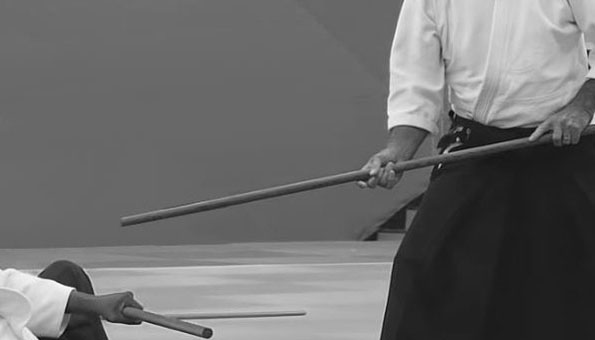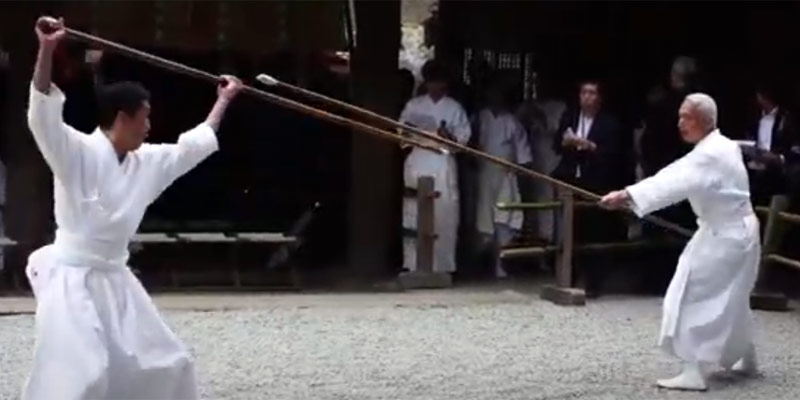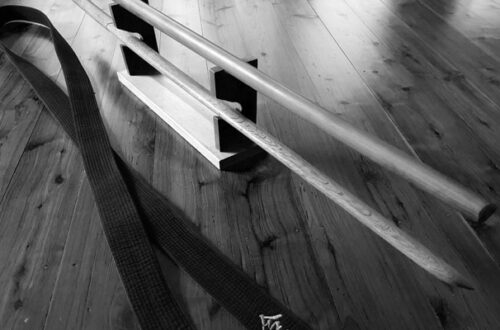
Ueshiba’s Jo in Aikido: Unification of Martial and Spiritual Principles
The history of the jo 杖 in Aikido can be traced back to the founder of Aikido, Morihei Ueshiba, who was known for his extensive martial arts training, including the art of the jo.
The origins of the jo in Japanese martial arts can be traced back even further, to the 17th century, when Muso Gonnosuke 夢想權之助, a samurai who was defeated in a duel with the legendary swordsman Miyamoto Musashi 宮本武蔵, developed a new form of martial art that focused on the use of a short staff, which he called Shindo Muso Ryu Jojutsu 神道夢想流杖術.

Shindo Muso Ryu Jojutsu 神道夢想流杖術
Over time, jojutsu was also incorporated into other martial art styles, each with their own set of techniques and training methods. Shindo Muso Ryu remains the most prominent, which focuses on the use of the jo against various weapons, including the sword. Some believe that Morihei Ueshiba might have had some exposure to Shindo Muso Ryu, but there is no definitive record of that. In fact, most evidence suggests that the jo in Aikido originated from Jukenjutsu 銃剣術 when Ueshiba was serving in the army. Jukenjutsu is a Japanese martial art that focuses on fighting with bayonets. It was developed during the Meiji period 明治時代 and was largely used by the Japanese army. Jukenjutsu is believed to have its origin from Sojutsu 槍術, which is a Japanese martial art of fighting with a yari 槍 (a Japanese spear).

Ueshiba demonstrating jukenjutsu 銃剣術
In his book, A Life in Aikido: The Biography of Founder Morihei Ueshiba, Kisshomaru Ueshiba 植芝吉祥丸, the second Doshu, briefly mentioned that his father had practiced Hozoin Ryu Sojutsu 宝蔵院流槍術. Hozoin Ryu Sojutsu is a school of spear techniques founded by Kakuzenbo In’ei 覚禅房 胤栄, a Buddhist monk of Kofuku-ji 興福寺 (Kofuku Temple) in Nara 奈良. It employs a special spear called the jumonji-yari 十文字槍, which has a cross-shaped spearhead said to have been conceived by In’ei when he saw the reflection of the moon on a pond. The unique design made the spear especially effective in combat.
However, no details about the time, people, or location were provided in the book. Some opinions suggest that Ueshiba may have had exposure to Hozoin Ryu while staying at the Omoto-kyo 大本教 headquarter in Ayabe, but again there is no solid evidence to support this claim.

Hozoin Ryu Sojutsu 宝蔵院流槍術
Regardless of the origin, Ueshiba later developed his own unique approach to the jo, incorporating elements of his own Aikido techniques and principles. He believed that the use of the jo is an extension of the body. He emphasized the fluidity of movement, blending with an opponent’s energy, and redirecting that energy for a desired outcome.
During Morihei Ueshiba’s later stage of life in Iwama 岩間, he continued to develop and refine his approach to the use of the jo in Aikido, called Aiki Jo. With his renewed focus on the spiritual and philosophical aspects of Aikido, he saw the jo as more than just a weapon, but as a medium to embody spiritual ideals in a physical form. He believed that the jo represented a connection between the practitioner’s body and the universe. His jo teachings during this time emphasized the development of a deeper sense of focus and becoming more attuned to the natural rhythms of the universe.
The use of the jo in Aikido has continued to evolve after Ueshiba’s death in 1969, with different schools and instructors developing their own approaches and techniques. Among them, the Iwama style is the most famous. Today, the jo remains an important part of Aikido training.
Author’s Note: We appreciate your readership! This article serves as a preliminary introduction to the subject matter. While we aim for accuracy, we cannot guarantee the content’s precision and it may contain elements of speculation. We strongly advise you to pursue additional research if this topic piques your interest. Begin your AikidoDiscovery adventure! 🙂



